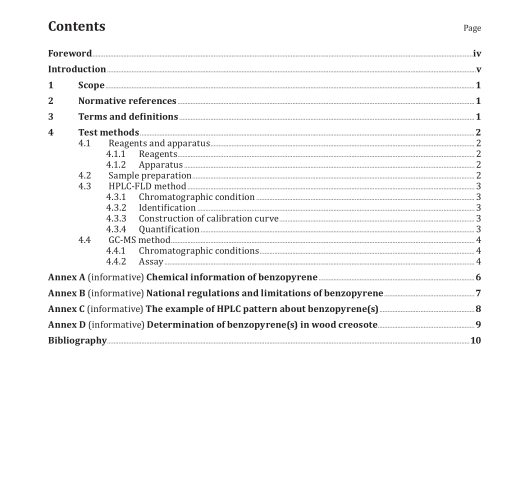ISO 23956:2022 pdf download.Traditional Chinese medicine — Determination of benzopyrene in processed natural products.
4 Test methods
4.1 Reagents and apparatus
4.1.1 Reagents
4.1.1.1 Benzo[a]pyrene (BaP) standard [high-performance liquid chromatography (HPLC) grade].
4.1.1.2 3-Methylcholanthrene, HPLC grade as an internal standard.
4.1.1.3 n-Hexane, ethanol, dichloromethane and acetonitrile (HPLC grade).
4.1.1.4 Water (or equivalent) referred to as deionized water (DIW).
4.1.2 Apparatus
4.1.2.1 Rotary vacuum evaporator.
4.1.2.2 Visible nitrogen sample concentrator.
4.1.2.3 Solid phase extraction (SPE) tube vacuum manifolds.
4.1.2.4 Rotor-stator homogenizer (mechanical homogenizer).
4.1.2.5 Gas chromatography (GC) or mass spectrometry (MS).
4.2 Sample preparation
a) Add 5 g of sample powder to 100 ml water and then extract for 90 min using an ultrasonic bath with a cooling system.
b) Add 100 ml of hexane with 1 ml of internal standard (50 μg/kg or 50 μg/l: purity ≥ 96 % for analysis grade) to a mixture by homogenization for 5 min, and extract the samples mixtures in an ultrasonic bath for 30 min.
c) Transfer all mixtures into a separating funnel and collect the supernatants.
d) Extract the residue twice with 50 ml of hexane as detailed in step b).
e) Add water (50 ml; ≥ 18,2 MΩ) to the combined hexane fraction for washing and filter the hexane fraction using anhydrous sodium sulfate. Next, concentrate the hexane fraction at 45 °C using a rotary vacuum evaporator to approximately 2 ml.
f) Wash a Florisil SPE cartridge with 10 ml of dichloromethane for activation. Clean the cartridge using 20 ml of hexane to remove dichloromethane.
g) Transfer directly 2 ml of the extracts into the activated Florisil SPE cartridge and elute the extracts with 20 ml of hexane and dichloromethane mixture (volume ratio of 3:1).
h) Concentrate the eluent using a visible nitrogen sample concentrator at 35 °C. Dissolve the residue in 1 ml of acetonitrile and filter the eluent through a 0,45-μm polytetrafluoroethylene (PTFE)
membrane filter.
i) Inject 10 μl of the final eluent into the fluorescence detector (FLD) for BaP analysis.
4.3 HPLC-FLD method
4.3.1 Chromatographic condition
— Column: supelcosil LC-PAH (4,6 × 250 mm, 5 μm) or equivalent.
— Column temperature: 35 °C.
— Detector: excitation at 294 nm and emission at 404 nm.
— Mobile phase: acetonitrile and water mixture (volume ratio of 8:2)
— Flow rate: 1 ml/min.
4.3.2? Identification
The retention time of the peak should be consistent with the retention time of the standard within ± 0,2 % under identical analysis conditions.
4.3.3 Construction of calibration curve
a) Dissolve standard (BaP) and internal standard (3-methylcholanthrene) in acetonitrile (1 μg/ml each). Store this stock solution at 4 °C. Replace the stock solution every six months.
b) Prepare standard solutions with different concentrations of 3 ng/ml, 5 ng/ml, 10 ng/ml, 20 ng/ml and 40 ng/ml with 50 ng/ml of internal standard to determine linearity.
c) Adjust the concentration of test solution in range of the calibration curve.
4.3.4? Quantification
In the calibration curve, the y-axis represents the ratio of the peak area of BaP to that of the internal standard (A s /A IS ), where A s is the peak area of the standard in solution for the calibration curve and A IS is the peak area of the internal standard in solution for the calibration curve. Calculate the content of BaP in the sample using the ratio of the peak area of BaP to that of the internal standard obtained by sample preparation (A SAM /A SAMIS ), where A SAM is the peak area of BaP in the sample extract and A SAMIS is the peak area of internal standard in the sample extract. An example of HPLC pattern about benzopyrene(s) in processed Rehmannia root is given in Annex C.
4.4 GC-MS method
4.4.1 Chromatographic conditions
— Column: Cross-linked 5 % phenylmethylsilicone, 30 m × 0,25 mm i.d. (0,25 μm), film thickness.
— Carrier gas flow: He at 1 ml/min.
— Injection port temperature: 300 °C.
— Transfer line temperature: 280 °C.
— Oven temperature (starting step): 50 °C for 1 min.
— Oven temperature (middle step): increase 10 °C /min until 180 °C.
— Oven temperature (starting step): increase 5 °C /min until 310 °C.
— Post run: 310 °C, 3 min.ISO 23956 pdf download.ISO 23956 pdf download
